Raman Scattering for Anisotropy of Polyacrylonitrile-Based and Pitch-Based Carbon Fibers
Abstract
1. Introduction
2. Materials and Methods
Materials
3. Results and Discussion
3.1. Raman Spectrum
3.2. Raman Scattering Parameter and Ratio Differences Between Carbon Fibers and CFRPs in Axial (0°) Section
3.3. Raman Scattering for Anisotropy of Carbon Fibers
4. Conclusions
- The Raman scattering parameters and ratios in the CFRPs are related to the tensile modulus. These linear trends for the PAN-based and pitch-based CFRPs intersect in the range of 400–700 GPa.
- The change in Raman scattering parameters and ratios of PAN-based and pitch-based CFRPs are related to the tensile modulus. These linear trends also intersect in the range of 400–700 GPa.
- The intensity ratio in an arbitrary angle could be estimated using the rule of mixtures and coordinate transformation equations.
Author Contributions
Funding
Data Availability Statement
Conflicts of Interest
References
- Chand, S. Review-Carbon fibers for composites. J. Mater. Sci. 2000, 35, 1303–1313. [Google Scholar] [CrossRef]
- Hamzat, A.K.; Murad, M.S.; Adediran, I.A.; Asmatulu, E. Fiber-reinforced composites for aerospace, energy, and marine applications: An insight into failure mechanisms under chemical, thermal, oxidative, and mechanical load conditions. Adv. Compos. Hybrid Mater. 2025, 8, 152. [Google Scholar] [CrossRef]
- Hannan, A.N.; Seidlitz, H.; Hartung, D.; Kuke, F.; Ambrosio, M.; Müller, M. Sustainability and circular economy in carbon fiber-reinforced plastics. Mater. Circ. Econ. 2024, 6, 26. [Google Scholar] [CrossRef]
- Seo, J.; Kim, D.C.; Park, H.; Kang, Y.S.; Park, H.W. Advancements and challenges in the carbon fiber-reinforced polymer (CFRP) trimming process. Int. J. Precis. Eng. Manuf. Green Technol. 2024, 11, 1341–1360. [Google Scholar] [CrossRef]
- Liu, H.C.; Zhu, S.; Chang, Y.Z.; Hou, W.J.; Han, G.Y. Pitch-based carbon materials: A review of their structural design, preparation and applications in energy storage. New Carbon Mater. 2023, 38, 459–473. [Google Scholar] [CrossRef]
- Shioya, M.; Takaku, A. Characterization of crystallites in carbon fibres by wide-angle X-ray diffraction. J. Appl. Crystallogr. 1989, 22, 222–230. [Google Scholar] [CrossRef]
- Takaku, A.; Shioya, M. X-ray measurements and the structure of polyacrylonitrile- and pitch-based carbon fibres. J. Mater. Sci. 1990, 25, 4873–4879. [Google Scholar] [CrossRef]
- Guigon, M.; Oberlin, A.; Desarmot, G. Microtexture and structure of some high tensile strength, PAN-base carbon fibres. Fibre Sci. Technol. 1984, 20, 55–72. [Google Scholar] [CrossRef]
- Guigon, M.; Oberlin, A.; Desarmot, G. Microtexture and structure of some high-modulus, PAN-base carbon fibres. Fibre Sci. Technol. 1984, 20, 177–198. [Google Scholar] [CrossRef]
- Csanádi, T.; Németh, D.; Zhang, C.; Dusza, J. Nanoindentation derived elastic constants of carbon fibres and their nanostructural based predictions. Carbon 2017, 119, 314–325. [Google Scholar] [CrossRef]
- Duan, S.; Liu, F.; Pettersson, T.; Creighton, C.; Asp, L.E. Determination of transverse and shear moduli of single carbon fibres. Carbon 2020, 158, 772–782. [Google Scholar] [CrossRef]
- Tane, M.; Okuda, H.; Tanaka, F. Nanocomposite microstructures dominating anisotropic elastic modulus in carbon fibers. Acta Mater. 2019, 166, 75–84. [Google Scholar] [CrossRef]
- Fujita, K.; Sawada, Y.; Nakanishi, Y. Effect of cross-sectional textures on transverse compressive properties of pitch-based carbon fibers. J. Soc. Mater. Sci. Jpn. 2001, 7, 116–121. [Google Scholar] [CrossRef] [PubMed]
- Naito, K.; Tanaka, Y.; Yang, J.M. Transverse compressive properties of polyacrylonitrile (PAN)-based and pitch-based single carbon fibers. Carbon 2017, 118, 168–183. [Google Scholar] [CrossRef]
- Shirasu, K.; Goto, K.; Naito, K. Microstructure-elastic property relationships in carbon fibers: A nanoindentation study. Compos. Part B Eng. 2020, 200, 108342. [Google Scholar] [CrossRef]
- Roy, D.; Kanojia, S.; Mukhopadhyay, K.; Eswara Prasad, N. Analysis of carbon-based nanomaterials using Raman spectroscopy: Principles and case studies. Bull. Mater. Sci. 2021, 44, 31. [Google Scholar] [CrossRef]
- Ferrari, A.C.; Robertson, J. Interpretation of Raman spectra of disordered and amorphous carbon. Phys. Rev. B 2000, 61, 14095. [Google Scholar] [CrossRef]
- Brubaker, Z.E.; Langford, J.J.; Kapsimalis, R.J.; Niedziela, J.L. Quantitative analysis of Raman spectral parameters for carbon fibers: Practical considerations and connection to mechanical properties. J. Mater. Sci. 2021, 56, 15087–15121. [Google Scholar] [CrossRef]
- Naito, K.; Nagai, C. Raman scattering for tensile testing of polyacrylonitrile-based and pitch-based single carbon fibers. Fibers 2024, 12, 88. [Google Scholar] [CrossRef]
- Qian, X.; Wang, X.; Zhong, J.; Zhi, J.; Heng, F.; Zhang, Y.; Son, S. Effect of fiber microstructure studied by Raman spectros-copy upon the mechanical properties of carbon fibers. J. Raman Spectrosc. 2019, 50, 665–673. [Google Scholar] [CrossRef]
- Okuda, H.; Young, R.J.; Wolverson, D.; Tanaka, F.; Yamamoto, G.; Okabe, T. Investigating nanostructures in carbon fibres using Raman spectroscopy. Carbon 2018, 130, 178–184. [Google Scholar] [CrossRef]
- Melanitis, N.; Tetlow, P.L.; Galiotis, C. Characterization of PAN-based carbon fibres with laser Raman spectroscopy. J. Mater. Sci. 1996, 31, 851–860. [Google Scholar] [CrossRef]
- Frank, O.; Tsoukleri, G.; Riaz, I.; Papagelis, K.; Parthenios, J.; Ferrari, A.C.; Geim, A.K.; Novoselov, K.S.; Galiotis, C. Devel-opment of a universal stress sensor for graphene and carbon fibres. Nat. Commun. 2011, 2, 255. [Google Scholar] [CrossRef]
- Wang, Y.; Alsmeyer, D.C.; McCreery, R.I. Raman spectroscopy of carbon materials: Structural basis of observed spectra. Chem. Mater. 1990, 2, 557–563. [Google Scholar] [CrossRef]
- Goto, K.; Naito, K.; Shirasu, K.; Watanabe, I. Numerical calculation and finite element analysis for anisotropic elastic properties of carbon fibers: Dependence of integration subinterval and mesh size on indentation-derived elastic modulus. SN Appl. Sci. 2022, 4, 291. [Google Scholar] [CrossRef]
- Jang, D.; Yoon, H.N.; Seo, J.; Cho, H.J.; Kim, G.M.; Kim, Y.K.; Yang, B. Improved electromagnetic interference shielding performances of carbon nanotube and carbonyl iron powder (CNT@CIP)-embedded polymeric composites. J. Mater. Res. Technol. 2022, 18, 1256–1266. [Google Scholar] [CrossRef]
- Johnson, W. The structure of PAN based carbon fibres and relationship to physical properties. In Strong Fibers; Watt, W., Perov, B.V., Eds.; Elsevier: Amsterdam, The Netherlands, 1985; Volume 1, pp. 389–443. [Google Scholar]
- Paris, O.; Loidl, D.; Peterlik, H. Texture of PAN- and pitch-based carbon fibers. Carbon 2002, 40, 551–555. [Google Scholar] [CrossRef]
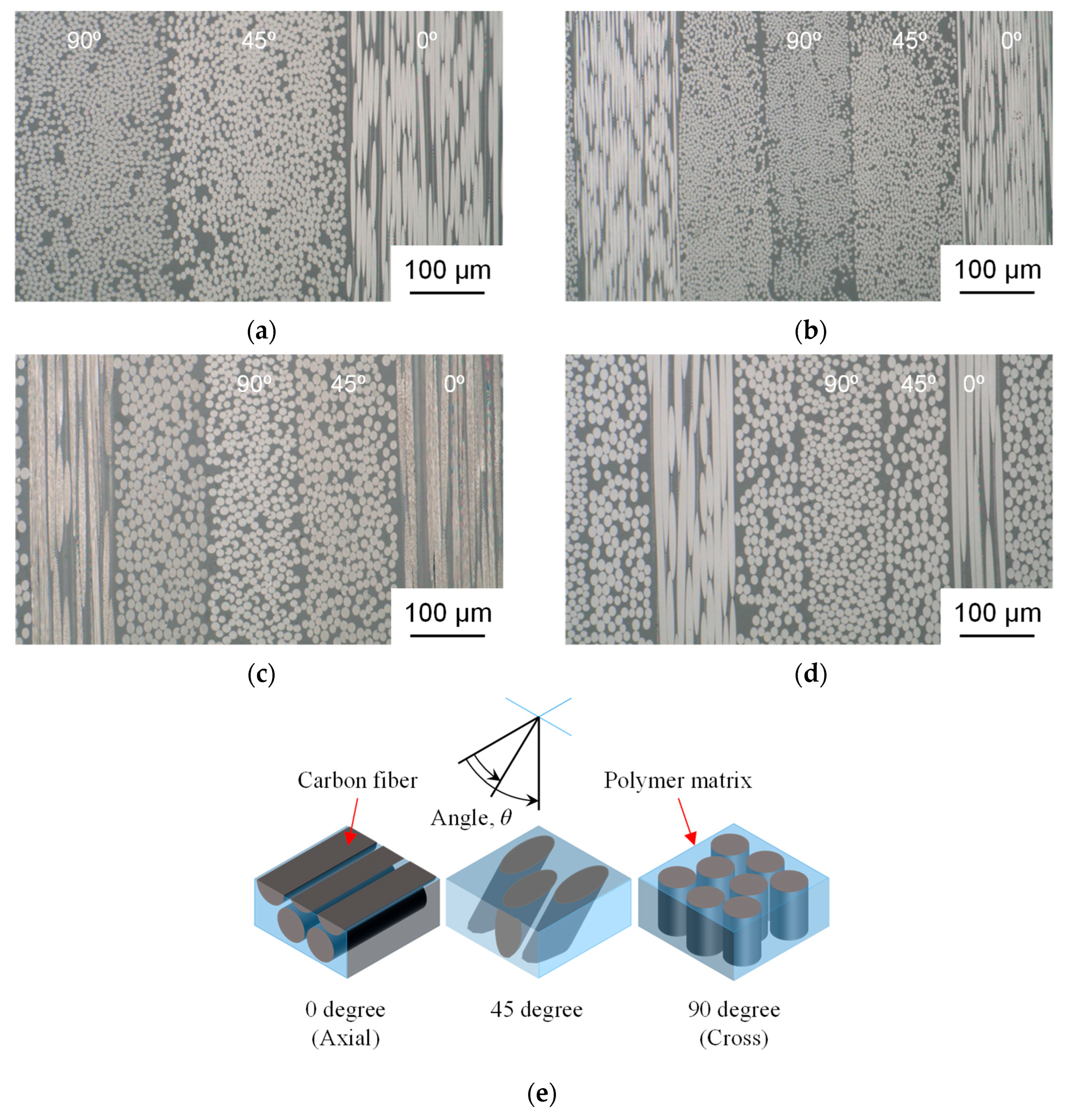

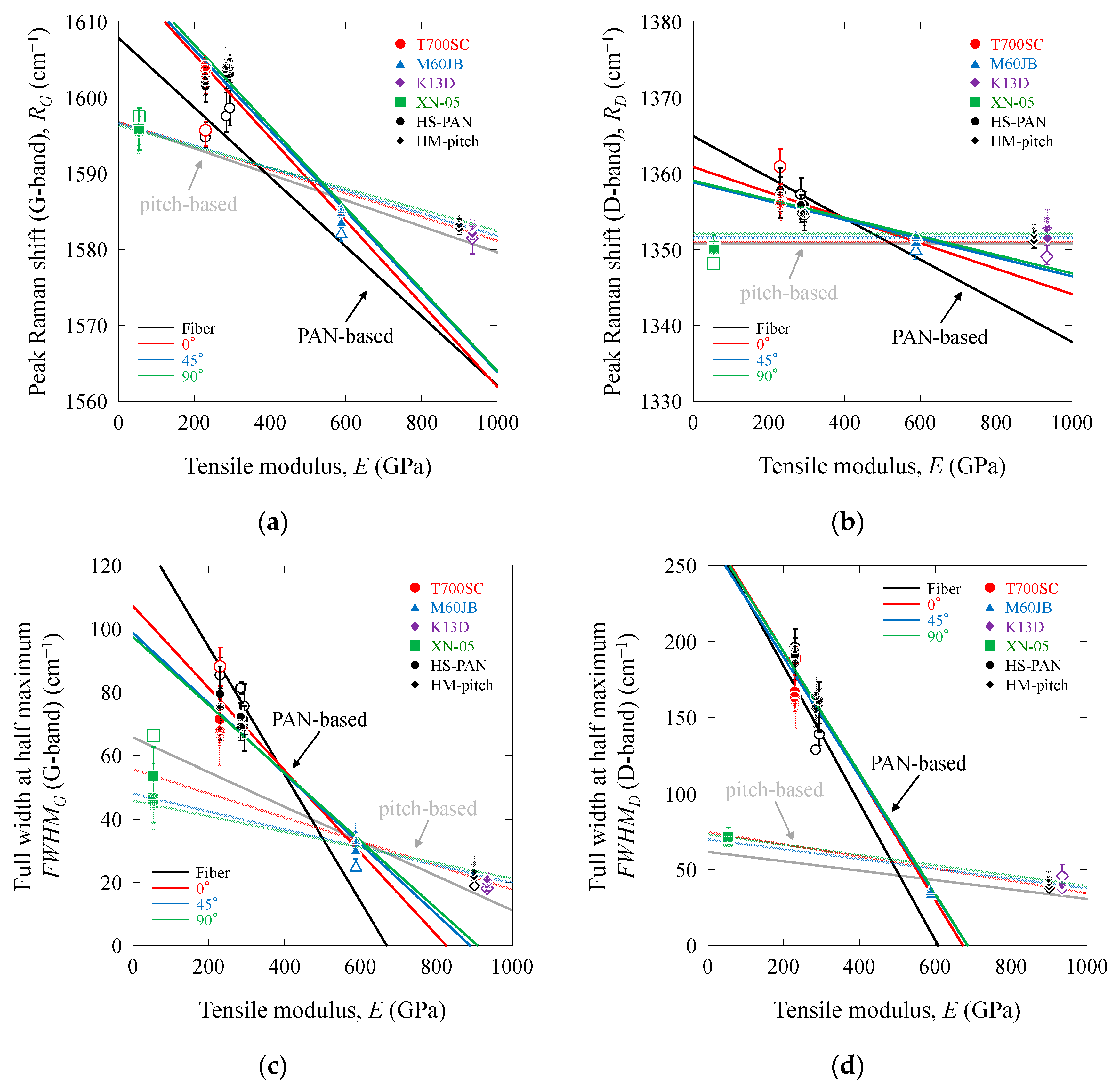
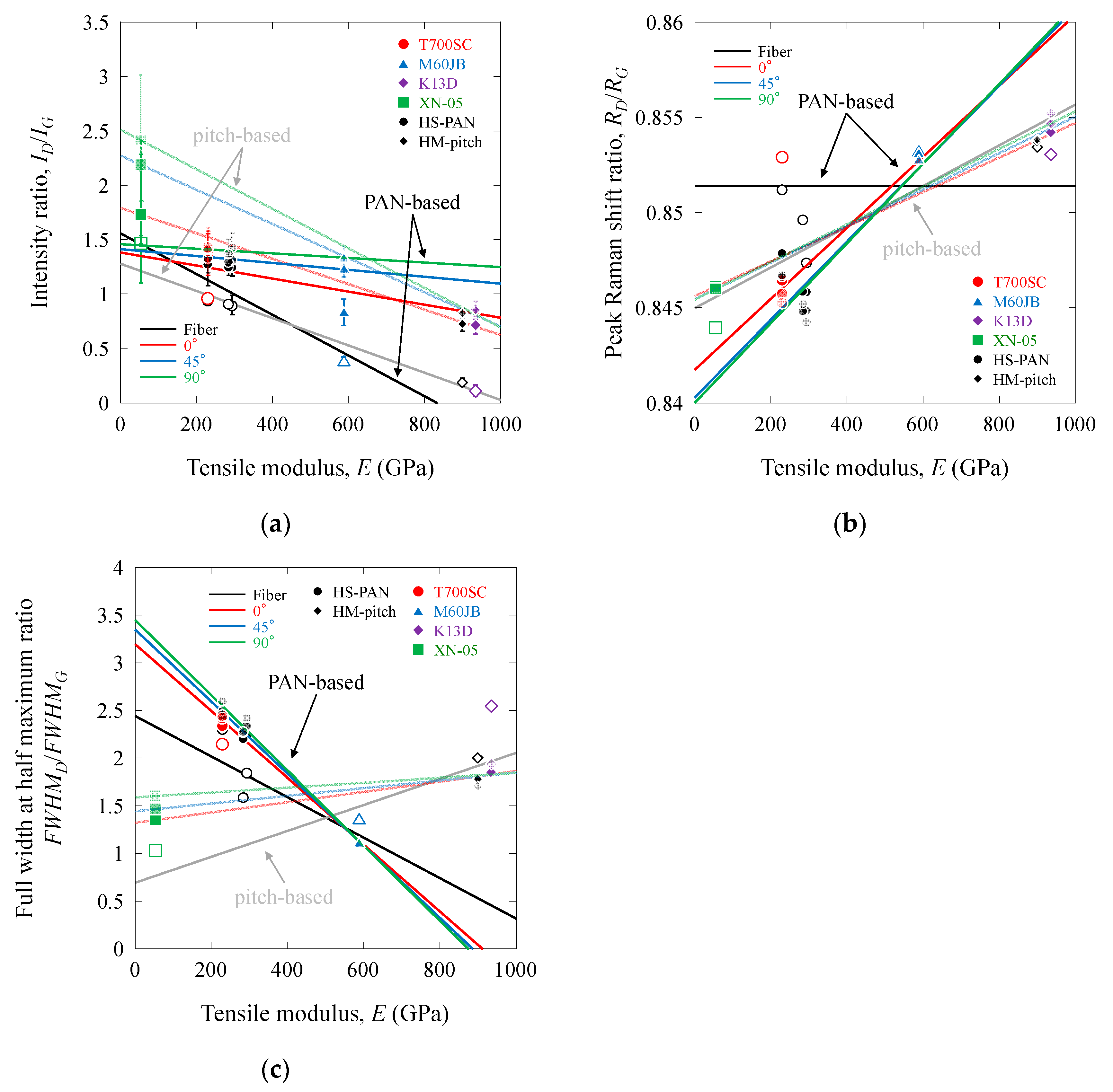
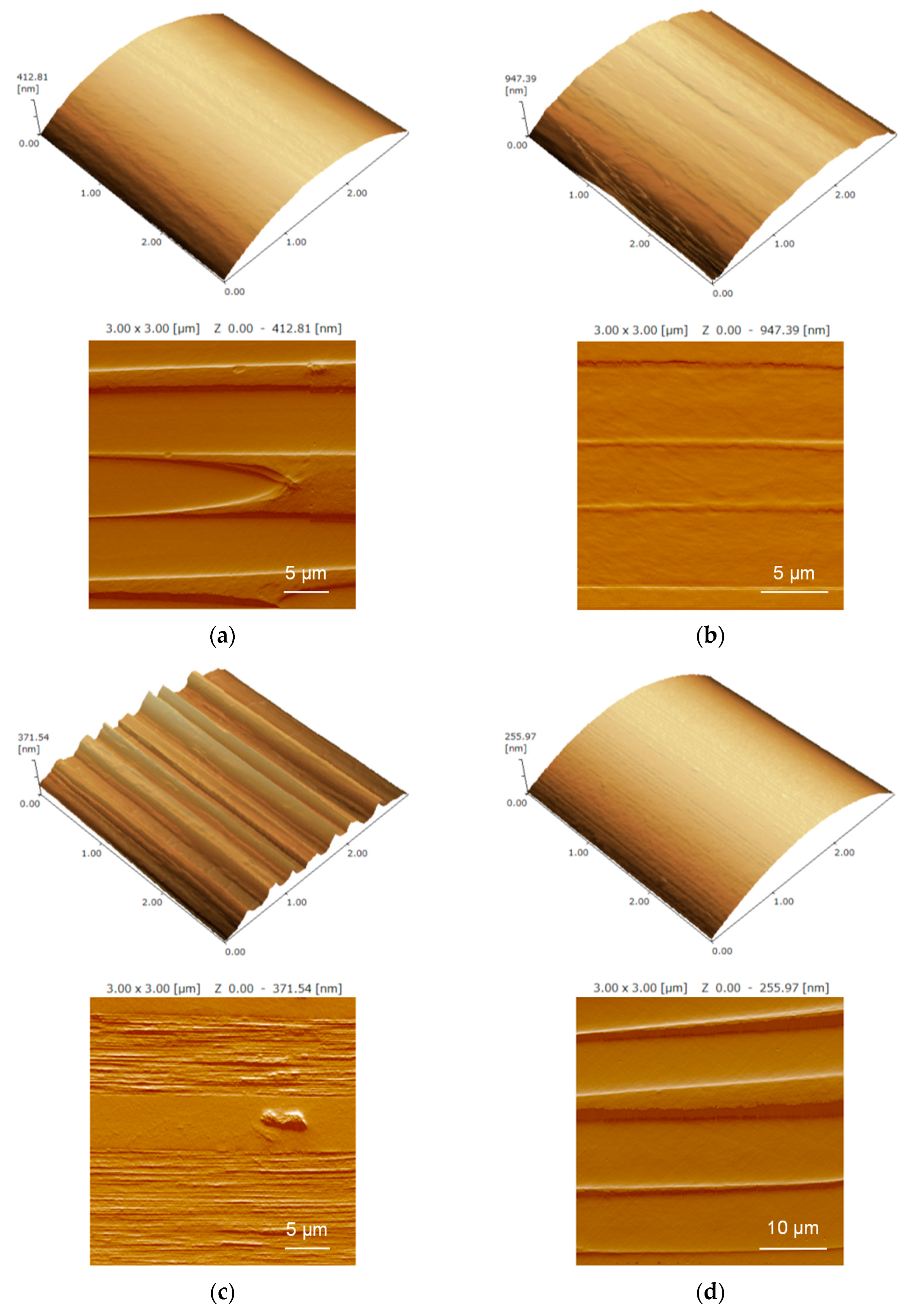



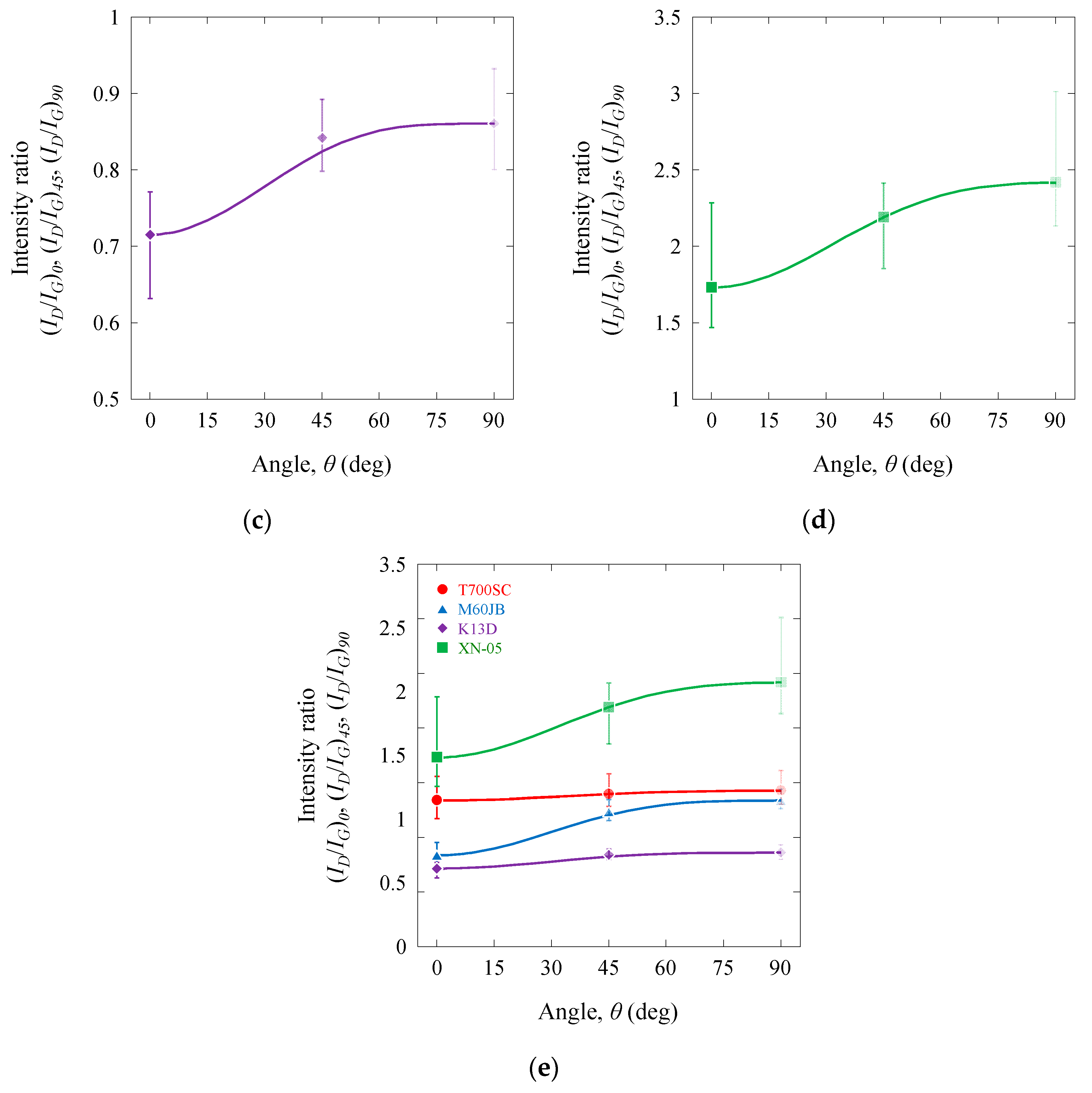
| HS-PAN | HM-PAN | HM-Pitch | HD-Pitch | HS-PAN | HM-Pitch | ||||
|---|---|---|---|---|---|---|---|---|---|
| T700SC | M60JB | K13D | XN05 | T300 | T800SC | IMS60 | K13C | ||
| Curing conditions | 180 °C 4 h | 120 °C 4 h 135 °C 2 h | 180 °C 4 h | 180 °C 4 h | 180 °C 4 h | 180 °C 4 h | 180 °C 4 h | 120 °C 4 h 135 °C 2 h | |
| Layer sequence | [0/+45/ 90/−45]14 | [0/+45/ 90/−45]26 | [0/+45/ 90/−45]26 | [0/+45/ 90/−45]34 | [0/+45/ 90/−45]20 | [0/+45/ 90/−45]s | [0/+45/ 90/−45]24 | [0/+45/ 90/−45]28 | |
| Fiber volume fraction, Vf | 0.539 | 0.574 | 0.545 | 0.565 | 0.492 | 0.523 | 0.567 | 0.542 | |
| Tensile modulus of fiber, Ef (GPa) *1 | 230 | 588 | 935 | 54 | 230 | 294 | 285 | 900 | |
| Peak Raman shift (G-band) RG (cm−1) | Fiber *2 0° 45° 90° | 1595.7 (0.9) 1602.7 (0.9) 1603.6 (0.7) 1604.2 (0.9) | 1582.2 (0.6) 1583.7 (0.3) 1585.0 (0.3) 1585.4 (0.3) | 1581.5 (0.5) 1582.2 (0.3) 1582.9 (0.3) 1583.2 (0.4) | 1597.5 (0.2) 1596.0 (1.5) 1595.9 (1.2) 1595.6 (1.3) | 1594.8 (0.9) 1601.5 (1.2) 1602.2 (1.0) 1602.8 (0.8) | 1598.6 (1.6) 1603.1 (0.6) 1603.9 (0.5) 1604.7 (0.7) | 1597.6 (1.6) 1603.0 (0.7) 1603.7 (0.6) 1604.2 (0.9) | 1583.2 (0.4) 1582.8 (0.3) 1583.3 (0.3) 1584.1 (0.3) |
| Peak Raman shift (D-band) RD (cm−1) | Fiber *2 0° 45° 90° | 1360.9 (1.3) 1356.6 (0.8) 1356.2 (0.9) 1355.9 (0.9) | 1350.0 (0.8) 1351.1 (0.2) 1351.7 (0.3) 1352.0 (0.3) | 1349.1 (0.8) 1351.5 (0.5) 1352.8 (0.5) 1354.0 (0.7) | 1348.2 (0.3) 1350.4 (1.0) 1350.1 (0.4) 1349.9 (0.6) | 1357.5 (1.4) 1357.8 (1.4) 1356.4 (1.2) 1357.1 (1.0) | 1354.6 (1.1) 1355.9 (1.0) 1355.1 (0.6) 1354.7 (0.6) | 1357.3 (1.6) 1355.9 (0.7) 1354.8 (0.7) 1355.8 (1.0) | 1351.2 (0.5) 1351.2 (0.4) 1351.9 (0.4) 1352.5 (0.4) |
| G-band full width at half maximum FWHMG (cm−1) | Fiber *2 0° 45° 90° | 88.1 (3.4) 71.5 (2.4) 67.7 (2.4) 65.3 (3.1) | 25.2 (0.5) 30.2 (0.5) 32.7 (0.8) 33.5 (1.1) | 18.0 (0.6) 19.8 (0.9) 21.1 (0.9) 20.8 (1.0) | 66.4 (0.5) 53.6 (4.3) 46.5 (4.4) 44.4 (4.6) | 85.3 (3.8) 79.4 (4.4) 74.7 (3.1) 75.3 (2.6) | 75.5 (4.0) 71.4 (3.2) 69.0 (1.4) 66.7 (2.3) | 81.3 (1.2) 72.6 (1.6) 69.0 (1.7) 72.1 (4.1) | 19.0 (0.8) 21.9 (0.5) 23.3 (0.5) 25.8 (1.3) |
| D-band full width at half maximum FWHMD (cm−1) | Fiber *2 0° 45° 90° | 188.7 (3.8) 166.8 (5.7) 163.2 (6.0) 159.2 (7.7) | 34.4 (0.6) 34.0 (0.5) 36.4 (0.8) 37.4 (1.0) | 45.9 (4.2) 36.8 (1.1) 39.0 (1.0) 40.3 (1.1) | 68.1 (0.5) 72.5 (2.9) 68.2 (1.0) 71.4 (2.7) | 196.0 (4.3) 190.9 (10.6) 185.5 (5.6) 195.0 (7.5) | 138.9 (4.8) 158.9 (7.1) 161.2 (4.3) 161.1 (4.0) | 128.8 (1.3) 159.5 (3.8) 155.9 (5.2) 164.0 (6.4) | 37.9 (1.0) 38.9 (0.8) 41.5 (0.8) 44.1 (1.4) |
| Peak Raman shift ratio RD/RG | Fiber *2 0° 45° 90° | 0.853 0.846 0.846 0.845 | 0.853 0.853 0.853 0.853 | 0.853 0.854 0.855 0.855 | 0.844 0.846 0.846 0.846 | 0.851 0.848 0.847 0.847 | 0.847 0.846 0.845 0.844 | 0.850 0.846 0.845 0.845 | 0.853 0.854 0.854 0.854 |
| Full width at half maximum ratio FWHMD/FWHMG | Fiber *2 0° 45° 90° | 2.142 2.333 2.411 2.439 | 1.367 1.127 1.113 1.116 | 2.545 1.859 1.849 1.936 | 1.027 1.354 1.466 1.610 | 2.297 2.403 2.485 2.590 | 1.838 2.224 2.335 2.414 | 1.585 2.197 2.259 2.274 | 1.999 1.777 1.781 1.707 |
| Intensity ratio ID/IG | Fiber *2 0° 45° 90° | 0.959 (0.032) 1.339 (0.108) 1.394 (0.077) 1.427 (0.076) | 0.390 (0.018) 0.836 (0.056) 1.235 (0.037) 1.338 (0.040) | 0.106 (0.029) 0.715 (0.043) 0.842 (0.024) 0.861 (0.037) | 1.467 (0.109) 1.731 (0.242) 2.191 (0.146) 2.418 (0.233) | 0.934 (0.023) 1.272 (0.100) 1.325 (0.078) 1.405 (0.049) | 0.888 (0.046) 1.244 (0.055) 1.311 (0.042) 1.422 (0.071) | 0.905 (0.016) 1.246 (0.033) 1.292 (0.051) 1.367 (0.081) | 0.187 (0.016) 0.728 (0.034) 0.820 (0.015) 0.829 (0.014) |
| Volume fraction | VOS (%) VOS(fiber) (%) | 0.537 4.37 | 6.36 24.1 | 1.55 55.8 | 45.7 61.7 | 1.05 4.74 | 1.27 5.45 | 1.29 5.19 | 1.40 28.3 |
Disclaimer/Publisher’s Note: The statements, opinions and data contained in all publications are solely those of the individual author(s) and contributor(s) and not of MDPI and/or the editor(s). MDPI and/or the editor(s) disclaim responsibility for any injury to people or property resulting from any ideas, methods, instructions or products referred to in the content. |
© 2025 by the authors. Licensee MDPI, Basel, Switzerland. This article is an open access article distributed under the terms and conditions of the Creative Commons Attribution (CC BY) license (https://creativecommons.org/licenses/by/4.0/).
Share and Cite
Naito, K.; Nagai, C. Raman Scattering for Anisotropy of Polyacrylonitrile-Based and Pitch-Based Carbon Fibers. Fibers 2025, 13, 114. https://doi.org/10.3390/fib13090114
Naito K, Nagai C. Raman Scattering for Anisotropy of Polyacrylonitrile-Based and Pitch-Based Carbon Fibers. Fibers. 2025; 13(9):114. https://doi.org/10.3390/fib13090114
Chicago/Turabian StyleNaito, Kimiyoshi, and Chiemi Nagai. 2025. "Raman Scattering for Anisotropy of Polyacrylonitrile-Based and Pitch-Based Carbon Fibers" Fibers 13, no. 9: 114. https://doi.org/10.3390/fib13090114
APA StyleNaito, K., & Nagai, C. (2025). Raman Scattering for Anisotropy of Polyacrylonitrile-Based and Pitch-Based Carbon Fibers. Fibers, 13(9), 114. https://doi.org/10.3390/fib13090114






